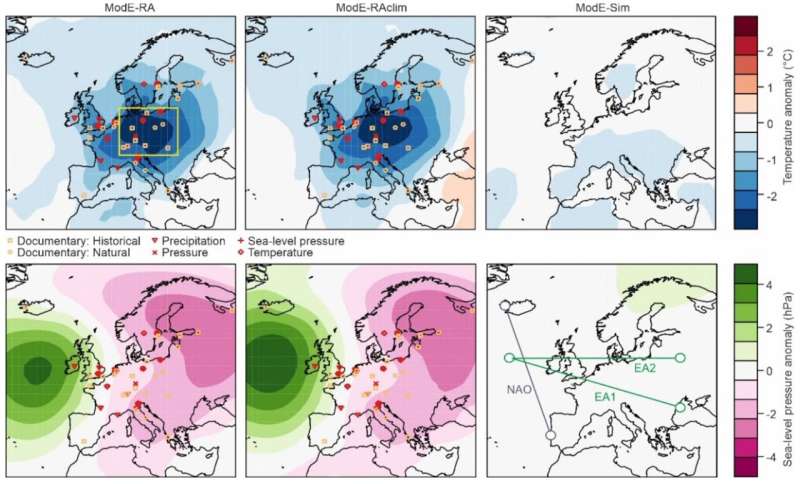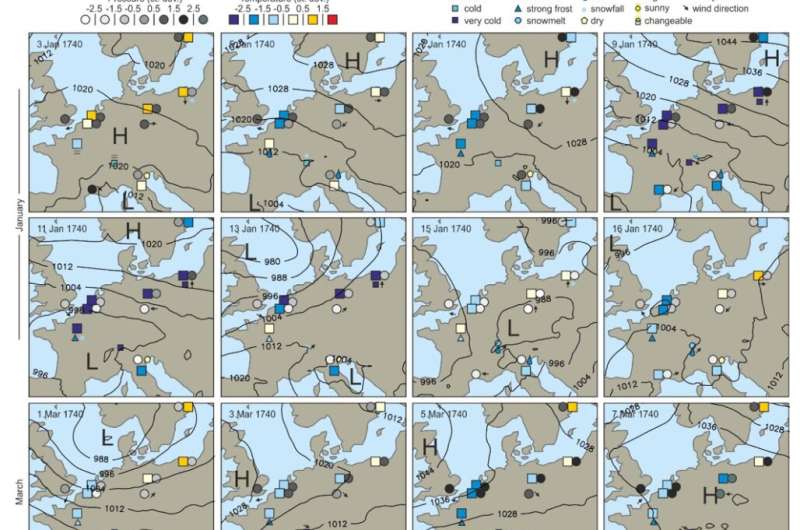Modeled reconstruction of annual mean temperature and sea-level pressure anomalies across Europe in 1740. Yellow rectangle defines boundary of Central Europe. Bottom right box outlines path of North Atlantic Oscillation (NAO) and East Atlantic Pattern (EA1/2). Credit: Brönnimann et al. 2024.
Europe experienced its coldest winter in 600 years during 1739–1740, ~4 °C cooler than the present average, also coinciding with negative temperature anomalies across North America and Eurasia. Indeed, for northern midlatitudes (35–70 °N) as a whole, it may have been the coldest season in the last 300 years.
At the time, there was heavy snowfall, severe frost and frozen rivers (ice thickness > 50 cm), which led to extreme flooding upon melting, the destruction of crops (in particular potatoes and cereals) and the death of cattle and fish. The famine that occurred in Ireland between 1740–1741 is believed to be a direct consequence of this disruption to food supplies.
While instrumental records existed, new global climate reconstructions have allowed scientists to investigate this anomalous season in further detail in a new publication in Climate of the Past. Professor Stefan Brönnimann, of the University of Bern, Switzerland, and colleagues reconstructed monthly climate and daily weather patterns in order to determine the mechanisms behind this extreme winter, which began in October 1739 and lasted through to June 1740.
The scientists combined instrumental measurements with weather diary observations from Gdańsk (Poland), Berlin (Germany), Versailles (France) and Saint-Blaise (Switzerland) to plot maps of daily temperature, pressure and weather patterns.
They identified the first half of January 1740 as being "extraordinarily" cold, 6 standard deviations below the mean temperature of Western Europe, which gradually spread southwards over the next few months and was coincident with a strong increase in atmospheric pressure initiated over Scandinavia. This had a blocking effect, causing cold air from the continent to flow westwards.
From February to June, high pressure prevailed over Ireland and drew cold air from the North Atlantic before spreading further over the European continent, causing two further negative temperature anomalies in March and May of that same year. Following this, the summer months of July and August experienced cold and rainy cyclonic weather patterns over Central Europe.
Temperature and pressure anomalies identified from instrumental measurements and weather diaries from Gdańsk (Poland), Berlin (Germany), Versailles (France) and Saint-Blaise (Switzerland) between January and August 1740. Credit: Brönnimann et al. 2024.
To explain these anomalies, the researchers investigated the role of the North Atlantic Oscillation, which was in a negative phase during 1740; this is when air pressure over the north and central North Atlantic Ocean is weaker, leading the jet stream to bring cooler temperatures and reduced precipitation. They found that this ocean-climate cycle was not experiencing extreme conditions during this particular year, so something else must have been driving the cold weather.
Instead, they turned to the East Atlantic pattern (similar to North Atlantic Oscillation but running east to west across the ocean basin), which experienced an unusual negative phase during spring 1740 (the first of its kind since these specific records began in 1421). This would have led to below-average temperatures across Europe as a whole, as well as below-average precipitation to the north and above-average to the south of the continent.
More information: Stefan Brönnimann et al, The weather of 1740, the coldest year in Central Europe in 600 years, Climate of the Past (2024). DOI: 10.5194/cp-2024-40
Journal information: Climate of the Past
© 2024 Science X Network

























